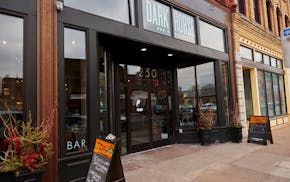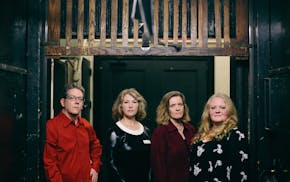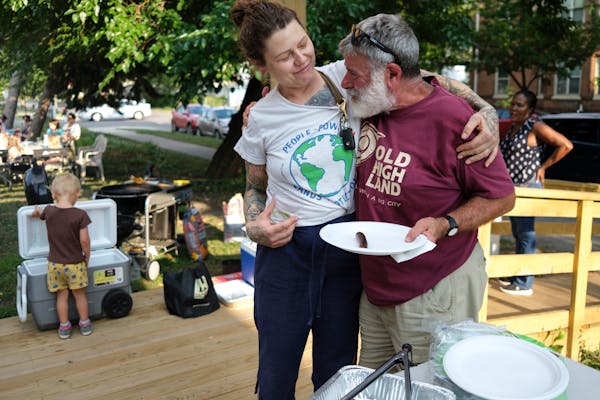During the growing season, Patricia Ohmans and Rennie Gaither, along with dozens of volunteers, can be spotted tending to plants at three gardens that make up Frogtown Green in St. Paul.
The garden group operates on a shoestring budget, but what it lacks in funding, the resident-led, volunteer-powered environmental initiative makes up for in spirit and mission.
"One of the biggest things is responding to climate change," Gaither said.
At its heart, Frogtown Green is an environmental effort with each garden carrying out that mission in different ways, from combatting urban drought to protecting nature's pollinators.
To date, Frogtown Green's volunteers and community partners have created a sprawling city park, built parklets and gardens, protected urban watersheds and planted hundreds of trees. The group also has nurtured the community by sponsoring dozens of events in Frogtown. According to the Frogtown Neighborhood Association, the area that makes up Frogtown just north of Interstate 94 is bordered by Lexington Parkway to the west, I-35E to the east, University Avenue to the south and W. Pierce Butler Route winding into Minnehaha Avenue to the north.
Frogtown Green took root in 2009 when Ohmans and other residents worked with local officials to transform underutilized or unused spaces into public gardens.
"I've been living in Frogtown for the past 42 years," said Ohmans, who nominated Frogtown Green, named a winner in the Star Tribune's Beautiful Gardens contest seeking gardens that do good.
"I'm a Master Gardener and I have a degree in public health, and all of those things converged in trying to create and maintain a healthy green space in my neighborhood."
Buzzing with activity
Each growing season at Monarch City Garden, more than 8,000 square feet of native pollinator-friendly wildflowers line the grounds of the West Minnehaha Recreation Center.
"Monarch City is intended as a reminder of the need to preserve and expand habitat for pollinating insects and birds," said Ohmans.
Throughout the spring, summer and fall, a handful of volunteers gather weekly to weed, mulch and deadhead pollinator plant beds. Each fall, the Minnesota State Horticultural Society organizes a group to collect seedlings from existing plants, sort them and distribute them for residents to store over the winter and prepare them for spring plantings.
To replenish the remaining wildflowers that will be needed, the West Minnehaha Recreation Center and St. Paul Parks and Recreation Department provide up to $700 in support annually.
The site also beautifies the well traveled W. Pierce Butler Route, not to mention serves as an educational tool. In the summertime, children's workshops are held weekly and a self-guided tour is available to the public for those wanting to learn about various native pollinator plants, from clustering milkweed to stalks of blazing stars and towering sunflowers to herbaceous anise hyssop, a late-season source for bees.
"Not all pollinator-friendly plants are native to Minnesota. The survival is better for native plants because they're more adaptable to drought conditions," Ohmans said.
The efforts of Monarch City Garden, which sprouted in 2016, have paid off. During the growing season, monarch butterflies and bees can be spotted daily. Not only that, 2021 garnered a major breakthrough that has created a buzz: three confirmed sightings of the rusty patched bumble bee, the state bee on the U.S. Fish and Wildlife Service's endangered species list.
"It was a big deal that those bees were identified here. It goes to show that if you create habitat, they will come," Ohmans said. "I think people are beginning to become more aware of plants that can thrive in Minnesota. If you want a carefree garden, you should plant a native garden."
It takes a village
A few blocks away, Our Village Garden sits on a half-acre at W. Pierce Butler Route and Milton Avenue. The community garden came about after the St. Paul Port Authority undertook a major remediation project of the former dumpsite. Frogtown Green organizers then stepped in to turn it into usable space.
Today, the park includes 40 garden beds, strolling paths, a trellis and a pergola. Trees have also been planted throughout the site.
Frogtown residents sign up for a garden bed, assigned each spring on a first-come basis, and plant vegetables during the growing season. Community events such as ice cream socials, concerts and harvest bonfires are also held.
Gaither — who last summer was growing a vegetable garden of okra, kale, cabbage, tomatoes and potatoes as well as a butterfly garden of things like Mexican sunflowers and milkweed — said he appreciates that Frogtown Green gardeners come from diverse backgrounds that bring their own brand of expertise to the group.
Stop by on any given day during the growing season, and it's not unusual to witness Somali, Hmong, Vietnamese, Karen or Spanish-speaking gardeners tending to beds of okra, peppers, tomatoes, squash and other produce.
One resident found just the right strategy and spacing of seeds to effectively grow towering husks of corn on a considerably small bed. Another gardener at Frogtown Green's Lily Pad Community Garden not too far away uses the leaves from the artichoke he grows for making tea.
"You see different garden practices including from immigrant families who are bringing their agricultural traditions here," Gaither said.
Tree frogs and lilypads
A few blocks away on Dale Street and Lafond Avenue, Lily Pad Community Garden can be found. The site spanning 25,000 square feet on what was previously a vacant city-owned lot aims to mitigate the effects of climate change through education.
The garden features exhibits and demonstrations on how to compost, create pollinator beds, plant trees, conserve water and more.
"What we're trying to demonstrate is that even on a limited budget you can do things that make your house cooler in the summertime or improve your soil for gardening so that you can grow your own food or conserve water or redirect water so that your basement isn't flooding," Ohmans said. "All of these small household affordable changes will make a difference."
The Lily Pad also serves as a nursery where a group of Frogtown Green volunteers who call themselves the "Tree Frogs" partner with the U.S. Forest Service, AmeriCorps, Tree Trust and neighborhood organizations to cultivate hundreds of fruit and shade trees each year. The volunteers then plant the trees in residents' backyards for free. Since its inception in 2012, more than 600 trees have been planted in St. Paul yards.
"Climate change is going to affect our neighborhood more harshly than other neighborhoods that have more trees and more green space and more resources," said Ohmans.
Now, as Frogtown Green prepares for another growing season, Monarch City volunteers are getting seedlings ready for spring planting. Garden beds are being assigned at Our Village Garden. And at Lily Pad Community Garden, the group is making more space with the goal of planting a total of 1,000 trees by 2025.
In addition to its growing environmental mission, Frogtown Green organizers hope that the fruits of their labor will resonate throughout the community in other ways.
"I think this is a way of countering a [negative] stereotype of the neighborhood," Ohmans said. "It's the type of thing that doesn't always make the news. Frogtown is so much more than meets the eye."
For more information on Frogtown Green, visit frogtowngreen.com.

The 5 best things our food writers ate this week

A Minnesota field guide to snow shovels: Which one's best?

Summer Camp Guide: Find your best ones here

Lowertown St. Paul losing another restaurant as Dark Horse announces closing

